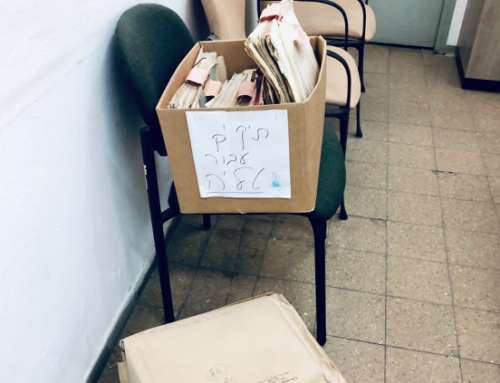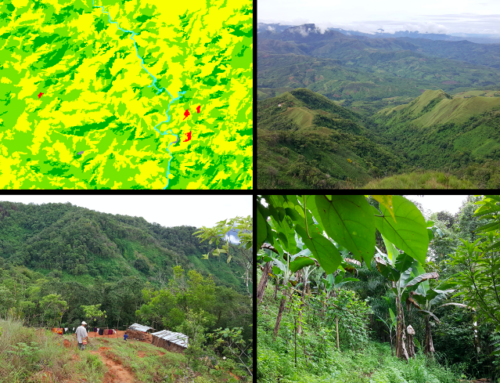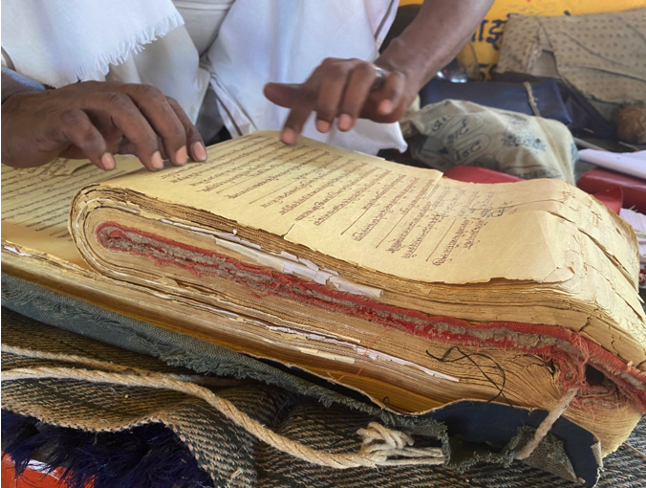
Figure 1: A scribe attempting to locate an entry in the bahī. Photo by author.
Much postcolonial scholarship over the last several decades has focused on the singular reificatory power exerted by imperial techniques of rule, such as censuses, surveys of land, or language, and on Empire’s consequent ability to shape the colonized world in the image of its many misconceptions. Anthropology has long admitted its complicity—its genesis, even—in this colonial project. In the case of South Asia, however, as Burghart (1996, 89) has pointed out, anthropologists—imperial or otherwise—were not alone; in their exploration of “the Indian subcontinent as an arena of anthropological interpretation,” anthropologists found it “already occupied and defined by local counterparts—Brahmans and ascetics who spoke about the social universe in the name of Brahma.” A remarkable formulation, no doubt; but while Burghart takes great pains to disaggregate several generations of ethnographers in terms of their changing theoretical stakes, his picture of the “Brahmin” appears strangely unchanged from the ‘scholar-ascetics’ who find mention in the earliest colonial tracts on India.
I use this essay to work out some of the implications of taking Burghart’s claim—of seeing pandits qua anthropologists—at face value, in the light of my recent ethnographic fieldwork. I do this by means of a (necessarily preliminary) examination of centuries-old[1] genealogical ledgers (bahīs) maintained by ritual specialists (panḍās) in the north Indian city of Allahabad. Neither bureaucratic nor straightforwardly historical documents, nor inscribed social memory—though they have elements of all three—these ledgers can be said to represent indigenous knowledge-practices that have long operated in a field of intelligibility distinct from, and parallel to, that of the state.[2]
Sorted by village and caste, bahīs are typically cloth-bound and are comprised of anywhere from 300-400 pages, with each page being roughly 8×30 inches. When not in use, each ledger is tied shut with an attached piece of rope (both to keep individual pages from curling and to allow the ledgers to be stacked). Bahīs last for 70-100 years, after which point the pages generally become too brittle to be useful as genealogical record. In most cases, the contents of older ledgers are copied over by hand into new books before this happens, a process which typically takes a few months for each ledger, with the older bahīs eventually being discarded by immersing them in the Ganga. While panḍās occasionally inscribe bahīs themselves, most depend on networks of professional scribes whose job it is to maintain and update these ledgers.
In what follows, I follow Friedrich Kittler—in what is by now a methodological path well-trodden (see Koopman 2019)—in attending to the “informatics” rather than “hermeneutics” of these pilgrimage ledgers. That is, rather than focusing on the information contained therein, I attempt to work out some of the implications of the ways in which this information is formatted. By thus attending to the material affordances of bahīs—that paper allows for re-inscription and overwriting, and erasure, for instance, or that it persists but also that it decays—I attempt to show that far from the procrustean preoccupations of imperial technologies of rule, we find here traces of a different apparatus of governmentality whose implications remain to be investigated.
The Affective Significance of the Bahī
Before turning to the ledgers themselves, the first thing that perhaps needs to be highlighted about them is that they are not, strictly speaking, “archives” at all. Instead, I see them as inhabiting a space between “archive and repertoire,” to borrow a concept from performance theorist Diana Taylor.[3] While it is beyond the scope of this essay to develop this point in depth, I will note simply that the ledgers serve not so much as repositories of data—notwithstanding the rich genealogical record contained therein—as prompts for the pandit to share from his store of local lore, genealogical knowledge, and Puranic myth.
The ledgers are marked as powerful long before they are opened, even outside of the heightened affective register of the mortuary rituals during which they are primarily accessed.[4] Much of this has to do with the care with which they are handled—stored and tied in ways which immediately stand out as peculiar, handled with much ceremony, their pages browned and brittle with age, turned gingerly, their classificatory schemes all but opaque to most pilgrims.
Much of this affective charge also has to do with the way that they index pilgrimages[5]: while many pilgrims were illiterate, those who could often wrote notes describing their pilgrimage adjacent to their entries, or sometimes just left signatures (or thumb impressions) in the ledger that would be carefully cut out and pasted into new ledgers when copied (see figure 3). Apocryphal stories abound of pilgrims bursting into tears at the sight of their ancestors’ handwriting. Figure 2 shows an example from a ledger from Lahore (now in Pakistan), which bears inscriptions in three scripts—Devanagari, in which the genealogy itself is recorded, and Nastaliq and Roman, in which pilgrims have inscribed their marginalia.[6]
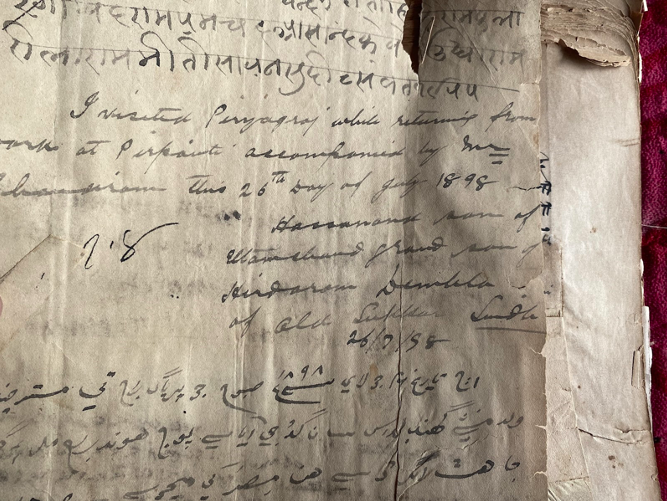
Figure 2: Excerpt from a bahī for Lahore (now in Pakistan) showing marginalia inscribed by pilgrims. Photo by author.
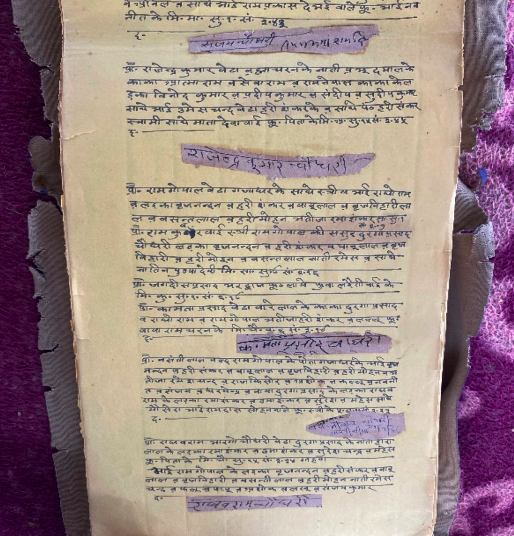
Figure 3: Signatures from an older ledger transferred into a new one. Photo by author.
Critique of Classificatory Reason
Coming to the logic of their classification, I had been told that bahīs were sorted by village and caste. However, as I began archival research, I was—perhaps overly conditioned by the state’s bureaucratic schemes of classification—nevertheless taken by surprise at the profusion of classificatory schemes throughout the ledgers. Mutually incommensurable and internally inconsistent, these ranged from revenue units of the British, Mughal, or Delhi Sultanate administrations, to references to erstwhile princely states, or even linguistic regions spread out over several states, in addition to the Indian state’s nested picture of state, district, village.
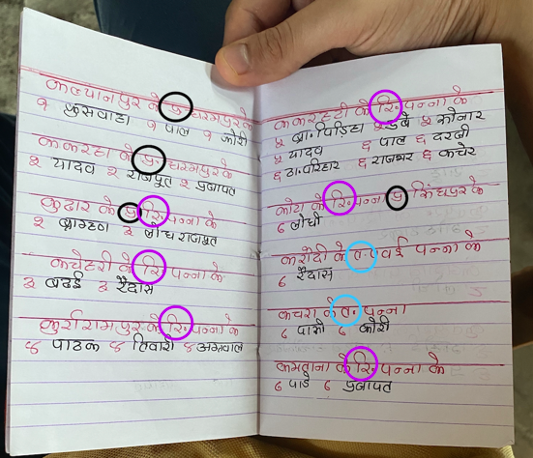
Figure 4: Excerpt from index of the bahī for Panna district in Madhya Pradesh. Black circles around ‘प्र’(‘Pr’), short for “Pargana”; Purple circles around रि (‘Ri’): short for “Riyasat” (estate); Cyan circles around त (‘Ta’), short for “Tehsil” (district). Photo by author.
Each of these foreground different imaginations of region and ontologies of power. And while one might be tempted to make the argument—from, as it were, the waiting room of history—that the profusion of classificatory schemes in the bahīs is a consequence merely of inertia, or perhaps an incomplete process of rationalization, for pilgrimage priests, it is much more a question of the terms in which pilgrims prefer to think of their attachments to their villages. While some districts happily identify themselves in accordance with the Indian state’s categories of revenue administration, older forms of regional identity nevertheless retain some vitality in other ledgers.
To take one example out of many, consider for a moment Figure 4. This is an image of the index-book from the bahī for the district of Panna in Madhya Pradesh. While each individual entry here (ten in the image) represents a village, locating this village in the broader region appears very much to be an open question, with some villages classified as being parts of districts (as the Indian state would have it), but others as being within the (erstwhile) estate of Panna, or parganas (a revenue classification of the Mughal state) therein.

Figure 5: Excerpt from the (old) bahī of Panna district from Madhya Pradesh. The name Ahīr is highlighted in green. Photo by author.

Figure 6: Excerpt from the (new) bahī of Panna district from Madhya Pradesh in the process of being renewed. The name Ahīr has been replaced by the name Yādav (highlighted in purple); all other details remain unchanged. Photo by author.

Figure 7: Excerpt from the (newly compiled) index of a bahī from Sahdol district in Madhya Pradesh. The name Yādav is highlighted in blue. Photo by author.
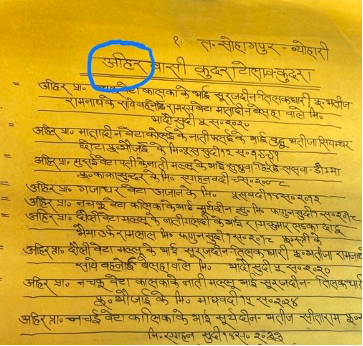
Figure 8: Excerpt from the (older) bahī from Sahdol district in Madhya Pradesh. The name Ahīr is highlighted in blue. Photo by author.
In lieu of a conclusion, and borrowing perhaps from the apophatic theology—”not this, not that”—of the Upanishads, I offer the exercise above as one in ground-clearing. Unlike Burghart’s description of the Brahmin as scholar-ascetic, steadfastly attuned, as it were, to the hereafter, we find among the panḍās an attention to detail that borders on the ethnographic. Unlike the state’s technologies of governmentality, we find that bahīs derive much of their power precisely from their ability to morph in accordance with pilgrims’ needs rather than from the creation of explanatory grids superimposed on society from on high. Contra Latour’s (1986) felicitous phrase—as he sought to explain the success of modern scientific/ bureaucratic techniques of inscription—bahis are neither quite “immutable” nor “mobile.” While a fuller analysis awaits, suffice it for now to say that these features of a provincial north-Indian pilgrimage site are as much a result of the affordances of the paper on which pilgrimage priests write as they are of their intentions: our writing tools, indeed, are working on our thoughts.
Notes
[1] It is difficult to say with certainty when this practice of keeping genealogical records might have emerged, although they date back at least to the 18th century. While Thapar (1991, 32-33) traces the idea back to the origins of literacy (specifically, to the “transmission of the Purānas in a literate form”), according to Bayly (1981, 159), the idea of maintaining genealogies at north Indian pilgrimage sites emerged during the first centuries of the common era, apparently as an extension of the mortuary ritual which mandated the propitiation of three generations of ancestors.
[2] It is in the light of this independence from the state that I intend the title of this piece to be read: a visual pun, I mean to imply not that the forms of knowledge I describe are not deeply imbricated in forms of power—quite the opposite, as we shall soon see—but rather to alert us to the fact that the implications of this form of power are by no means obvious, and in need of excavation (and that, tantalizing though it may be, an analytical move of the sort which sees these ledgers as indices of ‘Brahminical governmentality’ defers rather than solves the problem of working out these implications).
[3] Taylor (2003, 19) writes that while “‘[a]rchival’ memory exists as documents, maps, literary texts…all those items supposedly resistant to change…[t]he repertoire…enacts embodied memory: performances, gestures, orality, movement, dance, singing…all those acts usually thought of as ephemeral, nonreproducible knowledge.”
[4] While I cannot dwell on this at any length here, it might not be out of place to think of the bahīs’ ‘aura’ here, the invocation of Benjamin perhaps especially appropriate in the light of panḍās’ deep anxieties about digitizing these records.
[5] I invoke here CS Peirce’s tripartite distinction between ‘symbol, ‘index’, and ‘icon. To explain by way of a quick example: in Peircean semiotics, where the word ‘FIRE’ might serve as a ‘symbol’ of a fire, and the emoji (🔥) as its ‘icon’, the smoke emanating from that fire would be in a relationship of ‘indexicality’ to it, bearing as it does a “real connection” or “existential relation” to the fire (Nakassis 2018, 282).
[6] On this question of the ledgers’ affective charge, it may be instructive to read Lévi-Strauss as he attempts to reframe in The Savage Mind the supposed distinctions between “historical” or “rational” as opposed to “savage,” “prelogical,” or “mythopoetic” thought, by highlighting the affective charge of all archives: “The virtue of archives is to put us in contact with pure historicity….their value does not lie in the intrinsic significance of the events evoked: these can be insignificant or even entirely absent, if what is in question is a few lines of autograph or a signature out of context. But think of the value of…Bach’s signature to one who cannot hear a bar of his music without a quickening of his pulse….[Archives] give a physical existence to history, for in them alone is the contradiction of a completed past and a present in which it survives, surmounted. Archives are the embodied essence of the event” (Lévi-Strauss 1966, 242).
References
Bayly, CA. 1981. “From Ritual to Ceremony: Death Ritual and Society in Hindu North India since 1600.” In Mirrors of Mortality: Social Studies in the History of Death, edited by Joachim Whaley. Routledge: London.
Burghart, Richard. 1996. “Ethnographers and their Local Counterparts in India.” In The Conditions of Listening: Essays on Religion, History, and Politics in South Asia, edited by Fuller, Christopher J, and Jonathan Spencer, 88-112. New Delhi: Oxford University Press.
Koopman, Colin. 2019. How We Became Our Data: A Genealogy of the Informational Person. Chicago, IL: University of Chicago Press.
Latour, Bruno. 1990. “Drawing Things Together.” In Representation in Scientific Practice, edited by Michael Lynch and Steve Woolgar, 19-68. Cambridge, MA: The MIT Press.
Lévi-Strauss, Claude. 1966. The Savage Mind. London: Weidenfeld and Nicholson.
Michelutti, Lucia. 2008. The Vernacularisation of Democracy: Politics, Caste, and Religion in India. New Delhi: Routledge.
Nakassis, Constantine. 2018. “Indexicality’s Ambivalent Ground.” Signs and Society, 6 (1): 281-304.
Taylor, Diana. 2003. The Archive and the Repertoire: Performing Cultural Memory in the Americas. Durham, NC: Duke University Press
Yadav, Yogendra. 2000. “Understanding the Second Democratic Upsurge: Trends of Bahujan participation in Electoral politics in the 1990s”. In: F. Frankel [et.al] (Eds.), Transforming India: Social and Political Dynamics of Democracy, 120-145. New Delhi: Oxford University Press.
Kunal Joshi is a PhD candidate at the Department of Anthropology, Johns Hopkins University. His current work focuses on the genealogies of specific ritual/ecological rhythms in North India, and the conceptual architecture one might be able to unearth if one takes seriously pilgrimage priests’ ritual/ intellectual traditions.
Cite As: Joshi, Kunal. 2023. “Power ≠ Knowledge: Governmentality in North Indian Pilgrimage Ledgers” In “data/Big Data in the field” edited by Naveeda Khan, American Ethnologist website, December 22 2023, [https://americanethnologist.org/data-big-data-in-the-field/power-≠-knowledge-governmentality-in-north-indian-pilgrimage-ledgers/]
